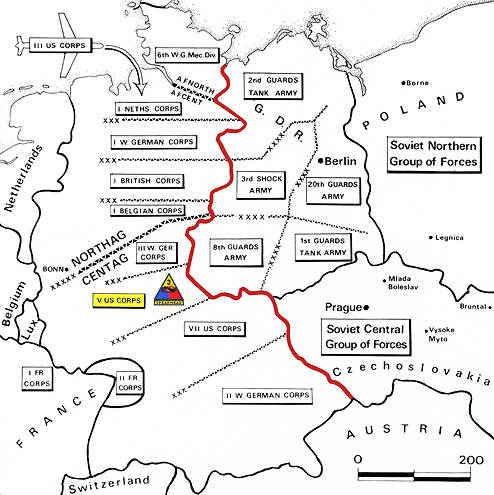| Cold War Home |
| Personal Site Home |
| Strategy |
| Weapons |
| Cold War and Culture |
| Victory |
| The map to the right highlights the Third Armored Division's responsibility. Most people know that the Soviet Union had a larger mass of men and machines to play with. However, many didn't realize the Russians' level of training was inferior (generally) to the U.S. On the other hand, outnumbering the enemy 2.5 to 1 in most areas of battle was a quality unto itself. Had the balloon went up, I might not be typing this. |
 |
The U.S. and NATO response to a Soviet threat varied throughout the years. In the 1950s, the general idea was to escalate to nuclear weapons quickly. As the decades wore on and the U.S. became involved in Southeast Asia, the strategy in Europe changed from a policy of "walking the nukes" to "flexible response," which stated that the U.S. Army would try to fight at the forward edge of the battle line, reacting to Russian moves. As the '60s turned into the '70s, defense budgets shrank as America recovered from the Vietnam experiment. In 1976, a new idea was published in the Army's doctrine: FM 100-5, otherwise known as AirLand Battle. AirLand Battle allowed superior-trained U.S. and NATO troops to beat back Soviet units, despite being at a numerical disadvantage. The doctrine called for fluid, moving defenses designed to whittle down Russian straightforward progress. The Fulda Gap was a low, easily navigable plain at the eastern edge of West Germany. If the Soviets were able to penetrate the valley, make their way to the Rhine River, they could break out into West Germany's industrial heartland, the Ruhr Valley. Once in the Ruhr, the Soviet Union had a relatively straight shot toward France, Bonn (the capital of W. Germany) and the Low Countries. Luckily, the U.S. didn't have to use OPLAN 4102, the still top-secret plan regarding troop movements and locations they would deploy to at the start of a conflict. |